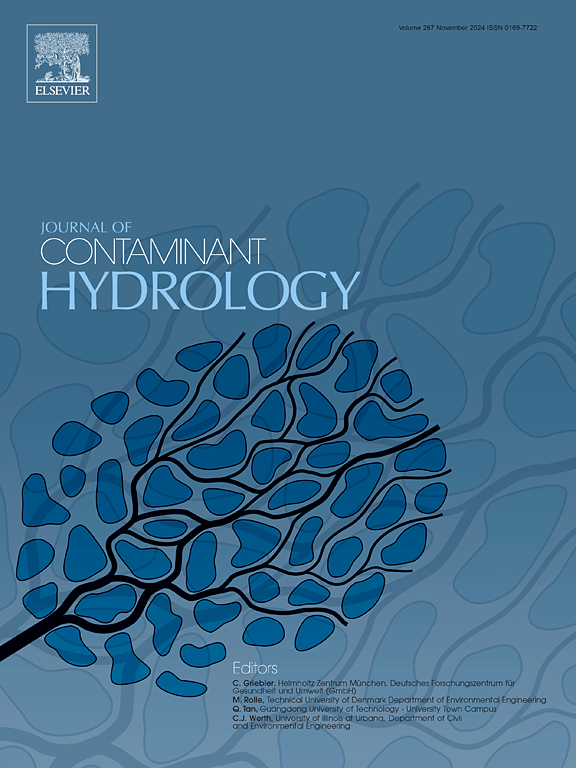Engineered injection and extraction combined with in situ oxidation remediation at an industrial site and evaluation of contaminant plume dynamics
IF 3.5
3区 环境科学与生态学
Q2 ENVIRONMENTAL SCIENCES
引用次数: 0
Abstract
Complex organic compounds derived from industrial production have caused serious pollution of groundwater and soil, persisting for prolonged periods within the seepage zone and aquifers. Engineered injection and extraction (EIE) combined with in situ remediation technology is widely used at industrial contaminated sites. However, detailed investigations and dynamic assessments of changes in the characteristic pollutants plume and quantification of restoration are still lacking. In this study, an investigation of the initial pollution plume and natural flow field was conducted at an organic contaminated industrial site in Eastern China. Chemical oxygen demand (COD) and ammonia nitrogen (NH3−N) were selected as indicator pollutants to monitor the dynamic changes of the pollution plume. A series of field tests including single well extraction and engineered injection and extraction, were conducted to reveal the transport mechanism and differential responses of pollutants during the extraction process. The results show that significant disparities were observed in the initial distribution and transformation behaviors of these pollutants within the flow field. The single-well extraction results identified an optimal extraction flow rate range for high pollutant removal efficiency. The long-term injection and extraction circulation test results revealed dynamic changes in the remediation efficiency across various extraction depths. Combining EIE and oxidation achieved a pollutant removal rate that exceeded 75 % in 72 % of the test area, effectively mitigating the pollution plume tailing. The contribution of injection-extraction cycles and in-situ oxidation to pollution remediation efficiency was quantified, and mechanistic analysis of the differences in COD and NH3-N transport behaviors was conducted. This study aims to provide a data foundation for the remediation of industrial contaminant sites.
工程注入和萃取结合工业现场的原位氧化修复和污染物羽流动力学评价
工业生产中产生的复杂有机化合物对地下水和土壤造成了严重污染,并在渗流区和含水层内长期存在。工程注入萃取(EIE)与原位修复技术相结合,在工业污染场地中得到了广泛的应用。然而,对特征污染物羽流变化的详细调查和动态评估以及恢复的量化仍然缺乏。本研究对中国东部某有机污染工业场地的初始污染羽流和自然流场进行了调查。选取化学需氧量(COD)和氨氮(NH3−N)作为指示污染物,监测污染羽流的动态变化。通过单井抽提和工程注入抽提等一系列现场试验,揭示了污染物在抽提过程中的运移机理和差异响应。结果表明,这些污染物在流场中的初始分布和转化行为存在显著差异。单井萃取结果确定了高污染物去除效率的最佳萃取流量范围。长期注抽循环试验结果揭示了不同萃取深度下修复效率的动态变化。EIE与氧化相结合,在72%的试验区实现了75%以上的污染物去除率,有效缓解了污染羽流尾。量化了注入萃取循环和原位氧化对污染修复效率的贡献,并对COD和NH3-N迁移行为的差异进行了机理分析。本研究旨在为工业污染场地的修复提供数据基础。
本文章由计算机程序翻译,如有差异,请以英文原文为准。
求助全文
约1分钟内获得全文
求助全文
来源期刊

Journal of contaminant hydrology
环境科学-地球科学综合
CiteScore
6.80
自引率
2.80%
发文量
129
审稿时长
68 days
期刊介绍:
The Journal of Contaminant Hydrology is an international journal publishing scientific articles pertaining to the contamination of subsurface water resources. Emphasis is placed on investigations of the physical, chemical, and biological processes influencing the behavior and fate of organic and inorganic contaminants in the unsaturated (vadose) and saturated (groundwater) zones, as well as at groundwater-surface water interfaces. The ecological impacts of contaminants transported both from and to aquifers are of interest. Articles on contamination of surface water only, without a link to groundwater, are out of the scope. Broad latitude is allowed in identifying contaminants of interest, and include legacy and emerging pollutants, nutrients, nanoparticles, pathogenic microorganisms (e.g., bacteria, viruses, protozoa), microplastics, and various constituents associated with energy production (e.g., methane, carbon dioxide, hydrogen sulfide).
The journal''s scope embraces a wide range of topics including: experimental investigations of contaminant sorption, diffusion, transformation, volatilization and transport in the surface and subsurface; characterization of soil and aquifer properties only as they influence contaminant behavior; development and testing of mathematical models of contaminant behaviour; innovative techniques for restoration of contaminated sites; development of new tools or techniques for monitoring the extent of soil and groundwater contamination; transformation of contaminants in the hyporheic zone; effects of contaminants traversing the hyporheic zone on surface water and groundwater ecosystems; subsurface carbon sequestration and/or turnover; and migration of fluids associated with energy production into groundwater.
 求助内容:
求助内容: 应助结果提醒方式:
应助结果提醒方式:


